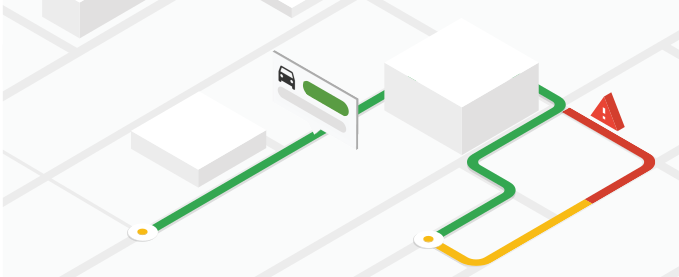
为何要使用 Directions API
借助 Directions API,您可以查询多种交通方式(如公交、驾车、步行或骑车)的路线。
您可以使用 Directions API 执行哪些操作?
借助 Directions API,您可以计算地点之间的路线,包括以下详细信息:
- 多种交通方式的路线,包括公交、驾车、步行或骑行。
- 使用一系列航点的多段式路线。
- 以多种方式指定出发地、目的地和途经点,包括以文本字符串(例如“伊利诺伊州芝加哥市”或“澳大利亚北领地达尔文市”)、地点 ID 或纬度/经度坐标的形式指定。
Directions API 的运作方式
在计算路线时,Directions API 会返回最有效的路线。在确定最有效路线时,该产品会考虑以下出行要素:
- 行程时间(主要)
- 距离
- 圈数
以下示例请求会以 JSON 格式返回从安大略省多伦多到魁北克省蒙特利尔的驾车路线:
https://maps.googleapis.com/maps/api/directions/json ?destination=Montreal &origin=Toronto &key=YOUR_API_KEY
资源
下表汇总了通过 Directions API 提供的资源及其返回的数据。
| 数据资源 | 返回的数据 | 返回格式 |
|---|---|---|
| 路线
以地点 ID、地址或纬度/经度坐标的形式提供起点和目的地。如需了解详情,请参阅必需参数。 |
详细路线,分为路线、路段和步骤。如需了解详情,请参阅路线响应。 |
|
如何使用 Directions API
| 1 | 开始设置。 | 首先设置您的 Google Cloud 项目,然后按照后续的设置说明完成操作。 |
| 2 | 试用演示版 | 获得 API 密钥和云项目后,您可以免费试用路线演示。请参阅 Directions API 演示。 |
| 3 | 构建请求 | 查看示例请求,并了解您可以提供的可用选项,例如出行方式、途经点和路线限制。请参阅路线示例。 |
| 4 | 了解响应基础知识 | 探索数据响应,为在应用中使用路线数据做好准备。如需了解详情,请参阅路线响应。 |
| 5 | 将方向数据纳入您自己的应用中! | 您可以使用此数据来计算行驶距离和时间。 |
可用的客户端库
通过以下客户端库之一,以您选择的语言调用此 API:
- 适用于 Google 地图服务的 Java 客户端
- 适用于 Google 地图服务的 Python 客户端
- 适用于 Google 地图服务的 Go 客户端
- 适用于 Google 地图服务的 Node.js 客户端
适用于 Google 地图服务的 Java 客户端、Python 客户端、Go 客户端和 Node.js 客户端是由社区提供支持的客户端库,并且根据 Apache 2.0 许可开放源代码。您可以从 GitHub 下载这些客户端库,还可以在其中找到安装说明和示例代码。
后续步骤
- 开始使用 Directions API:前往使用入门。
- 开始发出路线查询请求:前往获取路线。
- 遵循最佳实践:请参阅Web 服务最佳实践。

